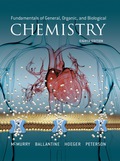
a)
Interpretation: Name of the given ion
Concept Introduction:
Naming monoatomic Ions: Main group metal cations are named by identifying the metal name, followed by the word ‘ion’.
Naming
Naming Anions: Anions are named by replacing the end of the element name with ‘-ide’, followed by the word ‘ion’.
b)
Interpretation: Name of the given ion
Concept Introduction:
Naming monoatomic Ions: Main group metal cations are named by identifying the metal name, followed by the word ‘ion’.
Naming Transition metal ion: In general, transition metal exhibits various oxidation state and the naming follows the rule, transition metal is identified by the name, followed by the oxidation number of the particular ion.
Naming Anions: Anions are named by replacing the end of the element name with ‘-ide’, followed by the word ‘ion’.
c)
Interpretation: Name of the given ion
Concept Introduction:
Naming monoatomic Ions: Main group metal cations are named by identifying the metal name, followed by the word ‘ion’.
Naming Transition metal ion: In general, transition metal exhibits various oxidation state and the naming follows the rule, transition metal is identified by the name, followed by the oxidation number of the particular ion.
Naming Anions: Anions are named by replacing the end of the element name with ‘-ide’, followed by the word ‘ion’.
d)
Interpretation: Name of the given ion
Concept Introduction:
Naming monoatomic Ions: Main group metal cations are named by identifying the metal name, followed by the word ‘ion’.
Naming Transition metal ion: In general, transition metal exhibits various oxidation state and the naming follows the rule, transition metal is identified by the name, followed by the oxidation number of the particular ion.
Naming Anions: Anions are named by replacing the end of the element name with ‘-ide’, followed by the word ‘ion’.
e)
Interpretation: Name of the given ion
Concept Introduction:
Naming monoatomic Ions: Main group metal cations are named by identifying the metal name, followed by the word ‘ion’.
Naming Transition metal ion: In general, transition metal exhibits various oxidation state and the naming follows the rule, transition metal is identified by the name, followed by the oxidation number of the particular ion.
Naming Anions: Anions are named by replacing the end of the element name with ‘-ide’, followed by the word ‘ion’.
Want to see the full answer?
Check out a sample textbook solution
Chapter 3 Solutions
EBK FUNDAMENTALS OF GENERAL, ORGANIC, A
- The following data were recorded for the enzyme catalyzed conversion of S -> P. Question: Estimate the Vmax and Km. What would be the rate at 2.5 and 5.0 x 10-5 M [S] ?arrow_forwardPlease helparrow_forwardThe following data were recorded for the enzyme catalyzed conversion of S -> P Question: what would the rate be at 5.0 x 10-5 M [S] and the enzyme concentration was doubled? Also, the rate given in the table is from product accumulation after 10 minuets of reaction time. Verify these rates represent a true initial rate (less than 5% turnover). Please helparrow_forward
- The following data was obtained on isocitrate lyase from an algal species. Identify the reaction catalyzed by this enzyme, deduce the KM and Vmax , and determine the nature of the inhibition by oxaloacetate. Please helparrow_forwardIn the table below, there are sketches of four crystals made of positively-charged cations and negatively-charged anions. Rank these crystals in decreasing order of stability (or equivalently increasing order of energy). That is, select "1" below the most stable (lowest energy) crystal. Select "2" below the next most stable (next lowest energy) crystal, and so forth. A B 鹽 (Choose one) +2 C +2 +2 (Choose one) D 鹽雞 (Choose one) (Choose one)arrow_forward1. Draw the structures for the fats A. 16:2: w-3 and B. 18:3:49,12,15 2. Name each of the molecules below (image attached)arrow_forward
- draw the structures for the fats A. 16:2:w-3 B 18:3:9,12,15arrow_forward1. Below is a template strand of DNA. Show the mRNA and protein that would result. label the ends of the molecules ( refer to attached image)arrow_forwardAttach the followina labels to the diagram below: helicase, single stranded binding proteins, lagging strand, leading strand, DNA polymerase, primase, 5' ends (3), 3' ends (3) (image attached)arrow_forward
- 1. How much energy in terms of ATP can be obtained from tristearin (stearate is 18:0) Show steps pleasearrow_forwardMultiple choice urgent!!arrow_forward1. Write the transamination reaction for alanine. Indicate what happens next to each of the molecules in the reaction, and under what conditions it happens. 2.arrow_forward
 Human Physiology: From Cells to Systems (MindTap ...BiologyISBN:9781285866932Author:Lauralee SherwoodPublisher:Cengage Learning
Human Physiology: From Cells to Systems (MindTap ...BiologyISBN:9781285866932Author:Lauralee SherwoodPublisher:Cengage Learning Principles Of Radiographic Imaging: An Art And A ...Health & NutritionISBN:9781337711067Author:Richard R. Carlton, Arlene M. Adler, Vesna BalacPublisher:Cengage Learning
Principles Of Radiographic Imaging: An Art And A ...Health & NutritionISBN:9781337711067Author:Richard R. Carlton, Arlene M. Adler, Vesna BalacPublisher:Cengage Learning





